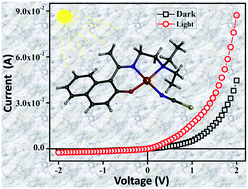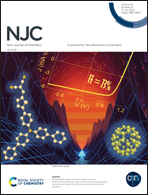Synthesis of an electrically conductive square planar copper(ii) complex and its utilization in the fabrication of a photosensitive Schottky diode device and DFT study†
Abstract
A new copper(II) complex [CuL(NCS)] with a naphthalene based Schiff base, HL = (1-(2-(diethylamino)ethylimino)ethyl)naphthalene-2-ol, has been synthesized and characterized by elemental analysis as well as single-crystal X-ray diffraction studies. The complex crystallizes in the monoclinic space group P21/a. The complex shows C–H⋯π interactions to form a supramolecular chain structure. The electrical conductivity of the complex has been recorded under dark and irradiated conditions and the measured I–V characteristics of the complex under dark and light conditions indicate highly non-linear rectifying behavior, thus signifying a Schottky diode nature. The material is also photosensitive as the values of the electrical parameters are enhanced after exposure to illumination of incident radiation. The optical band gap of the complex in the solid state (2.92 eV) has been determined by experimental measurements and compared with the theoretical value obtained from DFT calculations (2.99 eV).



 Please wait while we load your content...
Please wait while we load your content...